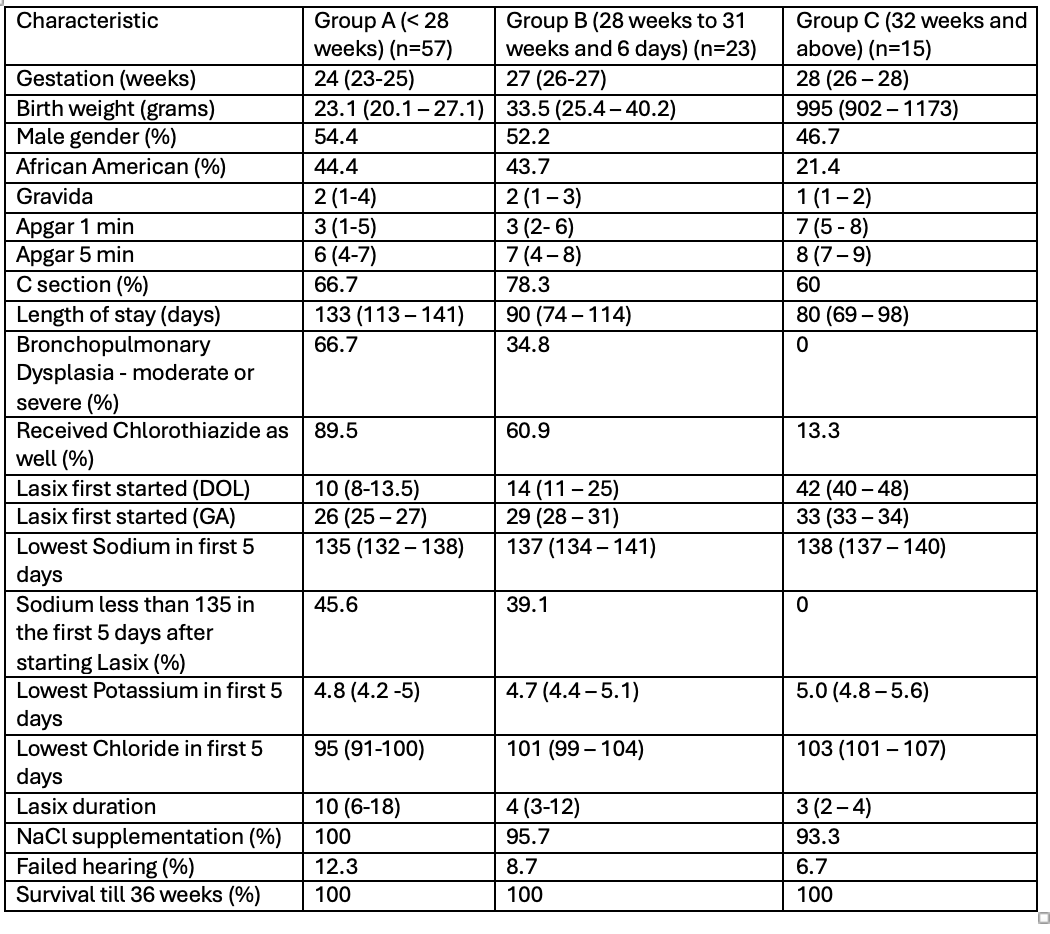Neonatal Pulmonology - Clinical 2: BPD: Incidence, Treatment, Outcomes
Session: Neonatal Pulmonology - Clinical 2: BPD: Incidence, Treatment, Outcomes
264 - Association of gestational age of starting Furosemide therapy and electrolyte imbalance, in extremely premature infants with chronic lung disease. A retrospective cohort study.
Friday, April 25, 2025
5:30pm - 7:45pm HST
Publication Number: 264.3706
Avneet Sohi, Cleveland Clinic Children's, Solon, OH, United States; Rakesh Lavu, Cleveland clinic children’s, Beachwood, OH, United States; Anirudha Das, Cleveland Clinic Children's, Cleveland, OH, United States
- RL
Rakesh Lavu, MD
Fellow
Cleveland Clinic Children's
Beachwood, Ohio, United States
Presenting Author(s)
Background: Furosemide (FS) is commonly used as a diuretic in extremely preterm infants with Chronic Lung Disease (CLD), with evidence suggesting it can improve pulmonary mechanics and oxygenation in infants older than 3 weeks. In our Neonatal Intensive Care Unit (NICU), FS is administered as a single daily dose of 1 milligram per kilogram (mg/kg) intravenously or 2 mg/kg orally, sometimes for three days, then continued every other day at the physician’s discretion. A second diuretic, Chlorothiazide, may be added for more severe lung disease. Electrolyte imbalance is a known short-term side effect of FS. We hypothesized that starting FS at an earlier gestational age would lead to a higher rate of short-term electrolyte imbalance without changing the severity of Bronchopulmonary Dysplasia (BPD).
Objective: The primary outcome was the lowest sodium (Na), potassium (K), and Chloride (Cl) levels within 5 days after starting FS. Secondary outcomes were Na level < 135 milliequivalents per liter (meq/L), a need for NaCl supplementation, and a failed hearing test.
Design/Methods: In this retrospective cohort study, we included infants born < 28 weeks gestational age (GA) over a three-year period (2021–2023) who received at least 3 doses of FS before 36 weeks postmenstrual age (PMA). The lowest Na/K/Cl levels within 5 days of FS initiation were recorded. Infants were categorized into 3 groups based on the GA at FS initiation: (a) < 28 weeks PMA, (b) 28–31 weeks PMA, and (c) ≥32 weeks PMA. Group comparisons were performed using the Kruskal-Wallis test.
Results: A total of 95 infants were included. Group A infants had the lowest GA (p < 0.001). FS was initiated in 57 infants at < 28 weeks PMA, in 23 infants between 28 and 31 weeks PMA, and in 15 infants at ≥32 weeks PMA. Na levels within 5 days of FS initiation were significantly lower in Group A compared to Groups B and C (p < 0.003), with significant differences also observed for K and Cl levels (p=0.03 and p< 0.001, respectively). The incidence of Na < 135 meq/L was highest in Group A (p=0.005). There were no significant differences between groups in Na supplementation (p=0.19) or hearing test outcomes (p=0.14). BPD incidence was significantly higher in Group A compared to the other groups (p < 0.001), with gestational age being the strongest predictor of BPD (p < 0.001), regardless of FS initiation timing (p=0.06).
Conclusion(s): Furosemide initiation at lower gestational ages is associated with significant electrolyte imbalances without affecting BPD incidence. These findings suggest that gestational maturity at FS initiation plays a key role in electrolyte stability.
Table 1
 Demographic characteristics, primary and secondary outcome of the population
Demographic characteristics, primary and secondary outcome of the populationFigure 1
.png) Boxplot diagram showing the lowest Sodium and Potassium levels within 5 days after starting furosemide in the three GA groups: < 28 weeks, 28-31 weeks, and 32 weeks or more.
Boxplot diagram showing the lowest Sodium and Potassium levels within 5 days after starting furosemide in the three GA groups: < 28 weeks, 28-31 weeks, and 32 weeks or more.
